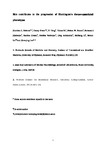Bim contributes to the progression of Huntington's disease-associated phenotypes

Date
2020-01-15Author
Subject
Metadata
Show full item recordAbstract
<jats:title>Abstract</jats:title> <jats:p>Huntington’s disease (HD) is a neurodegenerative disorder caused by an expanded polyglutamine (polyQ) tract in the huntingtin (HTT) protein. Mutant HTT (mHTT) toxicity is caused by its aggregation/oligomerisation. The striatum is the most vulnerable region, although all brain regions undergo neuronal degeneration in the disease. Here we show that the levels of Bim, a BH3-only protein, are significantly increased in HD human post-mortem and HD mouse striata, correlating with neuronal death. Bim reduction ameliorates mHTT neurotoxicity in HD cells. In the HD mouse model, heterozygous Bim knockout significantly mitigates mHTT accumulation and neuronal death, ameliorating disease-associated phenotypes and lifespan. Therefore, Bim could contribute to the progression of HD.</jats:p>
Collections
Publisher
Place of Publication
Journal
Volume
Issue
Pagination
Recommended, similar items
The following license files are associated with this item:

